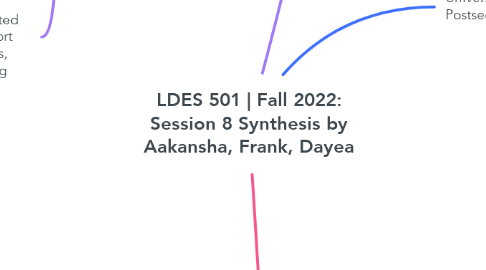
1. Thoughts and comments on UDL
1.1. Rather than thinking about how to make design choices that work for everyone, we should instead think about our choices from the standpoint of uplifting the disadvantaged folks, and in doing that there may be a fallout where we leave the always advantaged folks a little disadvantaged - this is where the “justice” concept comes into play. (Fikayo)
1.2. Instead of making students reveal their personal disabilities (even just to the university and even if it makes them uncomfortable), UDL designs for both hidden and visible accommodations to be accounted for. (Kathleen)
1.3. I also thought about the future tasks of Universal Design, and I thought that more research on the effectiveness and efficiency of this learning design should be conducted, as well as the time-saving of teachers and developers for the individualized education plan. (Dayea)
1.4. At the same time, UDL's courses can comprehensively consider students' physical and mental health. For example, some students may face the problem of a lack of self-confidence, complex integration of diverse backgrounds, or unable to keep up with the pace of the course. At this time, the emergence of UDL courses can help them regain their confidence and adapt to the domestic culture more quickly when they need CAST. (Tingjie)
1.5. Lastly, I assert that setting attainable goals is a proper UDL method that can help students learn. Students will have many opportunities to show that they have achieved each goal. With the use of goals, pupils can evaluate their development. These objectives are specific, measurable, and within reach of any learner. (Frank)
1.5.1. how can teachers objectively evaluate homework that is pictures, videos, and sounds in an academic fashion if the teachers themselves are not already experts in the audio-visual field? (Ruihan)
1.6. creating a learning environment from the start of designing a course/program and not “adapting when a situation requires it” (CNDLS), becomes critical to catering to students with different needs and abilities. (Haya)
2. Teaching to Transgress (bell hooks)
2.1. The integrity of educators' mind and body is the foundation to an engaged pedagogy. Even though hooks' piece focuses on liberatory education, I believe her points on integrity, wholeness, practice of freedom, self actualization hold truth to every disciplines and to every individual. (Paul)
2.2. I think striving for that inclusivity and accessibility takes a lot of intentional work. I’m curious to hear from peers what active steps you have taken towards practicing forms of engaged pedagogy if you have, and what challenges you seem to be facing. (Aakansha)
2.2.1. In some developing countries, teachers do not have the luxury and barely make ends meet from the penny they collect throughout the day-night job. Aside from that, upon this paper, I realize how vital the professor's attitude is to set the tone in the classroom. The superiority aura, authoritative gesture, and outdated module are no longer in line with the current era of learning. (Ambika)
2.2.1.1. I think it’s probably easier to convince students to start caring about more than just grades than it is to convince teachers to teach for more than just grades. (Pulkit)
2.3. hooks believes that teachers should strive toward self-actualization. She cites Thich Nhat Hanh's claim that teachers are healers, and that if they are unhappy, they cannot help others. I'm still a bit unsure about what it means for teachers to be healers and I wonder what is unique about the profession of education that its practitioners should seek self-actualization (compared to the practitioners of other professions) (Eric)
2.4. However, the human connections that emerge from that ensure that the students learn better and feel like they belong to a part of a community :)
2.4.1. How do you trigger such a change in the minds of instructors and teachers who still think that they simply know it all and are that ‘sage on the stage’? (Nikisha)
2.5. It made me think about how school systems, probably in most parts of the world, work–where teachers/instructors are expected to go out of their way to support their students, student families, and colleagues, all while being pressured to perform to the t. (Nikisha)
2.5.1. Who then checks in with them? How do we know whether they’re actually doing okay and have the bandwidth to teach in a classroom and provide their students with the best possible education and resources? (Nikisha)
3. Universal Design for Learning in Postsecondary Education (Rose)
3.1. In the article, the authors emphasized the idea that through universal design everyone benefits from the learning experience, not just those who are disabled (Rose et al., 2006, pp145, 150). Just how true is this? And is it really possible? And if possible is it feasible? (Fikayo)
3.2. Even if these are problems that the instructors cannot directly solve, they can provide support by directing them to alternative university resources. How do professors go about setting this precedent in their classes, especially when they are large-scale classes that are not particularly conducive to teacher-student interaction? Should professors explicitly talk about inclusivity and accessibility at the start of their classes or should it be the student's responsibility to read the syllabus and reach out if they need help? (Aakansha)
3.2.1. How do teachers recognize all of these disorders such as receptive aphasias (difficulty recognizing spoken words), visual agnosias (difficulty recognizing objects that are seen), dyslexias (difficulty recognizing written words), amusia (difficulty recognizing the patterns in music) and make their pedagogy universally approachable? (Odmaa)
3.3. If we understand UDL to be important, how do we introduce its principles at an institution that won’t readily accept them? In the same vein, how do we achieve UDL with less resources – especially less technology? (Hannah)
3.3.1. I wonder how this type of engaged pedagogy can be more feasible and sustainable for other institutions that have less resources than Harvard. (Paul)
